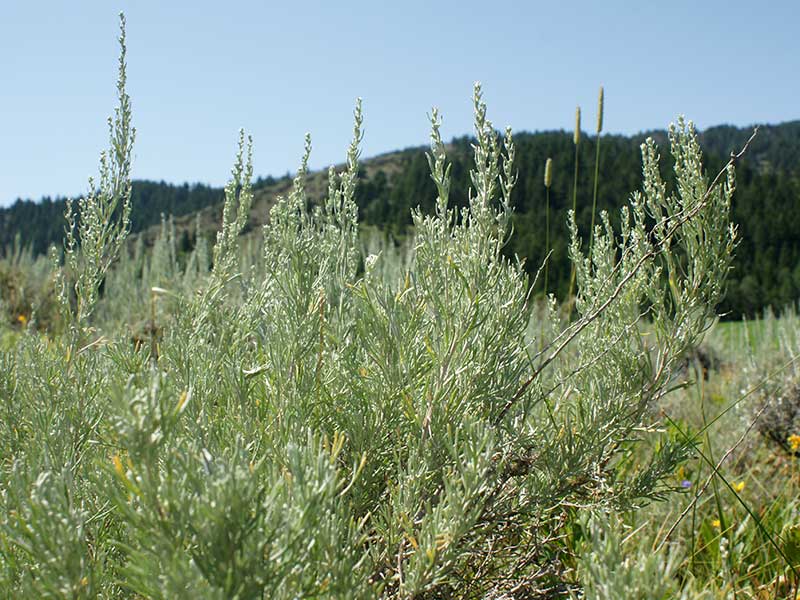Artemisia tripartita / threetip sagebrush
- evergreen shrub; branches in broom-like clusters
- all parts covered with silvery/grey-green glandular hairs
- leaves long and very deeply, very distinctly 3-lobed
- flowers in spikes/racemes – all bits teeny, overall yellow-ish/reddish
- often with mountain big sagebrush on nutrient poor soils
Also known as: tall threetip sagebrush, Wyoming threetip sagebrush, cutleaf sagebrush
Threetip sagebrush is an evergreen shrub growing up to 6 feet tall (west of the Continental Divide). The shrub is rounded in appearance due to its prolific branching, but it doesn’t look as woody or massive or spread out as the very common big sagebrush. Rather, the twigs are often in broom-like clusters. Threetip sagebrush is found throughout the west, and for some reason that I can’t get details of, A. tripartita on the USDA maps also shows up in New York. Go figure.
Like other Artemisia spp., threetip sagebrush plants – both stems and leaves – are pale grey to grey-green and densely tomentose. The hairs are glandular, making the whole plant distinctly aromatic. The stems, when they are big enough, have a dark grey shredding bark.
The most distinctive feature of threetip sagebrush is definitely its leaf shape. The leaves are long and very deeply, very distinctly 3-lobed and silvery/grey.
The inflorescence of threetip is as difficult to figure out as that of most other sagebrushes. Everything about them is pretty teeny. The involucres – which are about the most visible part of the flower heads – are turbinate (like little turbans) and not much more than 1/8 inch tall or wide. Like the stems and leaves, they are hairy. As a composite, each flower head has 3 to 11 disk florets but no ray florets. The corollas are yellowish to reddish, glandular hairy, and arranged in panicles or spikes. The overall arrays range from a couple inches to more than a foot long.
Threetip sagebrush flowers are hermaphroditic, i.e. having both male and female organs. Because they are wind pollinated, they produce copious amounts of pollen and are thus hyper-allergenic… like other sagebrushes.
Habitat: threetip commonly occurs in dry plains and hills of sagebrush steppe and grassland communities. Stands of threetip sagebrush often occur adjacent to mountain big sagebrush, but usually on moister soils at higher elevation. Like big sagebrush, threetip is tolerant of nutritionally poor soils.
Unlike big sagebrush, following disturbance (e.g. fire), threetip sagebrush has some limited ability to resprout from its shallow, lateral roots or the root crown. It can also spread by layering. Otherwise, it is commonly spread by seeding. The plants are prolific seeders and the small, light seeds, each with a dandelion-like pappus, are wind-dispersed. With that, it can seed back in to disturbed areas within 5 to 10 years. It is relatively insensitive to herbicides, so actually increases in density following eradication efforts.
Finally, there is one species that may be confused with threetip. Stiff sagebrush (Artemisia rigida) is similar but with a few differences in the inflorescences. When I find one, I’ll illustrate it. Meanwhile, the clearest difference is that the leaves of stiff sagebrush are deciduous with 3 to 5 deeply cleft lobes.
| Color | |
|---|---|
| Family | |
| Blossom size | |
| Inflorescence size | |
| Inflorescence type | |
| When? | |
| Where? |


